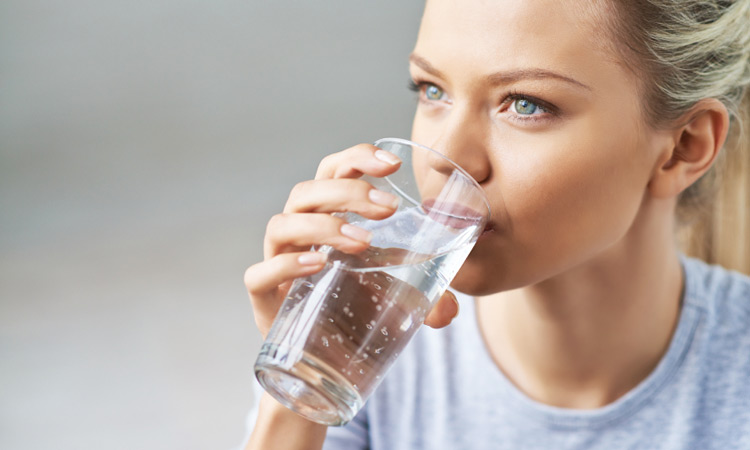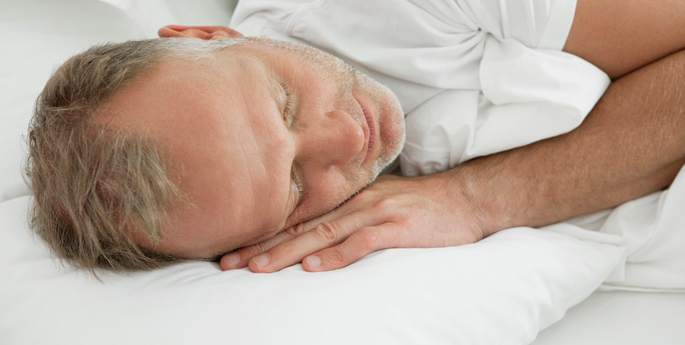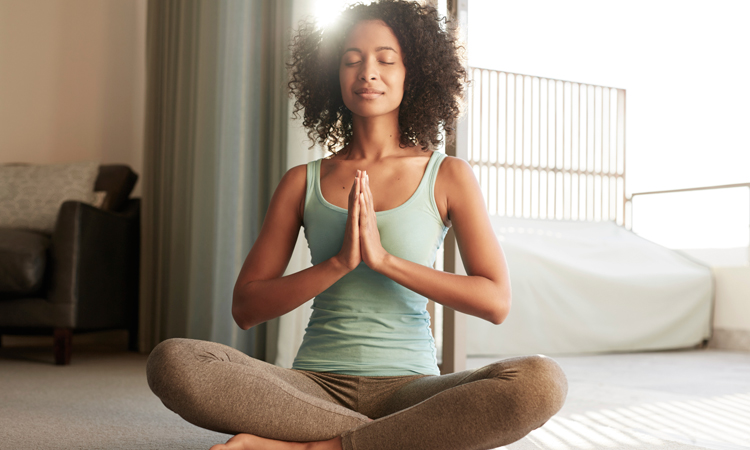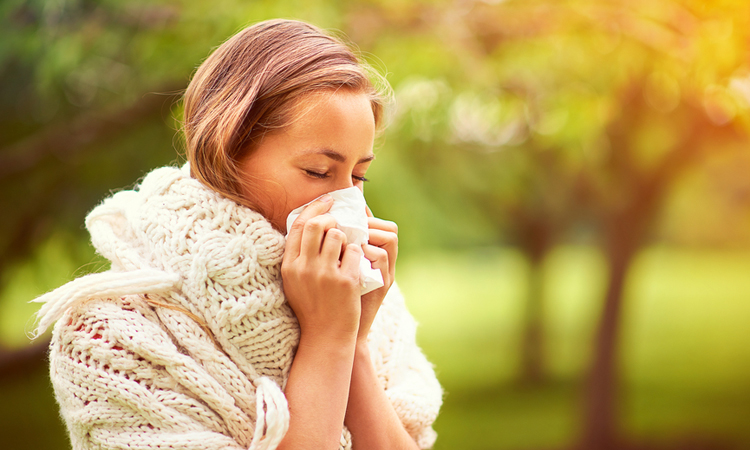“Looking to boost your immunity this winter? The best defense against the flu is practicing good health and hygiene.”
-Rose Caiola
Healthy ways to protect yourself against bacteria and viruses
Exposure to bacteria and viruses, along with mental and physical stressors, can all take a toll on the body and make you more susceptible to illness. The way we care for our bodies year-round, and especially during cold and flu season, can help boost our immune system and prevent contraction of these illnesses.
Colds versus allergies versus the flu
Sometimes symptoms of a cold can be confused with allergies. Tracking the time of the year and exposure to environmental or food allergens will help to identify the cause. In either case, supporting your immune system will be ideal.
A cold can be viral or bacterial in origin, with the most common cold due to rhinoviruses [3]. Symptoms usually last for one week, and you should avoid interacting with people while you are contagious for the first three days. Typical symptoms of a common cold include:
- runny nose
- cough
- sore throat
- slight or no fever
- congestion
- mucous (clear=allergies, white=viral, yellow=bacterial)
The flu is short for influenza and is a viral infection. Flu symptoms often have a quicker onset and are more severe than a common cold:
- slight sore throat
- high fever
- headaches
- muscle aches and soreness
- congestion
- cough
- fatigue lasting up to a few weeks
Viral replication peaks during rainy seasons, and the virus requires a host – such as a human, animal or insect – to survive and, therefore, is passed on between living organisms [16, 13]. The flu can cause a serious scare in over-populated areas due to its ability to rapidly spread and adapt.
The 6 Best Cold and Flu Fighting Strategies
During seasonal changes and warm, wet weather it is most important to strengthen your immune system to fight off invading microorganisms that are eager to grow and spread, using the cold and flu fighting strategies below:
- Practice clean hygiene
- Hydrate yourself
- Sleep and rest
- Botanical herbs for your health
- Breathing meditation
- Clean up your diet and avoid sugary foods
1. Practice clean hygiene
Preventative healthy hygiene practices are the most important way to limit spread of bacteria and viruses.
- Wash your hands often with soap and water for at least 20 seconds
- Sneeze into a tissue or elbow sleeve to prevent spread through mucous
- Avoid touching your face. Especially your nose, eyes and mouth where body fluids can carry more germs
- Routinely clean and disinfect food preparation surfaces and counters
- Safely clean and prepare foods, and avoid cross-contamination with raw meats and seafood
- Avoid using antibiotics for viral infections
2. Hydrate yourself

Drinking pure water will help to flush out toxins in the body and promote an efficient immune system. Adding in lemon gives an added boost.
Water makes up 60 percent of the adult human body and is critical for all major physiological systems [15]:
- serves as a vital nutrient to every cell
- regulates internal body temperature through sweating and respiration
- moistens tissues, such as mouth, eyes, nose, gut lining, skin
- protects the body, organs and vital systems, such as brain, spinal cord, fetus
- lubricates joints
- regulates digestion
- flushes waste products from the liver, lymph and kidneys
- supports blood to carry nutrients and oxygen to cells
- supports hormone and neurotransmitter synthesis
Unfortunately, most people are chronically dehydrated and often confuse thirst for hunger. Drinking six to eight glasses – two to two and a half liters – of water a day is a foundation to your health. Yes, coffee, tea, flavored water and foods still count towards your hydration; however, clean and pure water will always dominate.
Expert tip: Use elastic bands on your glass or water bottle to help you keep track. Put six to eight bands on your bottle first thing in the morning. As you drink one glass of water, approximately one cup, take a rubber band off the bottle and put it onto your wrist. After consuming all six to eight glasses, add the bands back to the bottle for the next day.
3. Sleep and rest

Sleep is crucial for strengthening your body, including your immune system, healing damaged tissue, mental recovery and hormonal balance. Read more if you’ve ever wondered “How Much Sleep Do I Need?.”
Often when we are sick, we feel more tired. This is a clue from your body telling you to rest in order to fight off infection, heal and recover from physical and mental stress [5].
Healing from tissue injury and microbial insult requires an anabolic – or building – state in order to deliver essential nutrients, white blood cells and pro-inflammatory cytokines – molecules to stimulate healing – to the affected area [1, 5]. Adrenaline is released during wakeful acute stress, which prevents cell division that is necessary for healing [1]. Adequate uninterrupted sleep and a relaxed nervous system (PNS) are crucial for recovery and strong immunity.
4. Botanical herbs for your health
Botanical herbs are another helpful nutraceutical for the changes of season. Here are a few of my favorites:
- Echinacea is a key herb used for bacterial infections, upper respiratory tract infections, sinusitis, recurrent candida infections and as a cold and flu prophylaxis [12].
- Ganoderma is also well known as reishi mushroom and as Ling zhi in Traditional Chinese Medicine. It is an immune modulator and reduces stress by calming the mind and nervous tension [8, 9, 10, 17].
- Astragalus is a wonderful immune activating herb that also acts as an anti-viral, anti-inflammatory and can decrease allergy induced nasal congestion. On a deeper level, it has protective actions for the heart, liver, kidneys and blood [6, 11, 18].
- Elderberry is also known as Sambucus canadensis. It is a tasty syrup that coats and soothes a sore throat while fighting off viruses targeting the upper chest and sinuses [2, 4].
5. Breathing meditation

Deep breathing, meditation and mind-body awareness allow your mind and body to rest while strengthening your immune’s defense system.
Psychological stress and depression impair anti-viral immune responses and activate innate immunity or markers of inflammation via effector pathways, such as the sympathetic nervous system and the hypothalamus-pituitary-adrenal (HPA) axis [7]. Taking full deep breaths of fresh air not only clears your lungs of carbon dioxide residue, but also puts you in a parasympathetic state to defend against potentially harmful microorganisms. Meditations and other mind-body therapies have been shown to reduce markers of inflammation and influence virus-specific immune responses.
6. Clean up your diet and avoid sugary foods
Give your body a break from heavy chemicals, irritants and sugars to help you fight off a throat tickle and have you feeling more vibrant and energetic. Also, add immune boosting foods to your diet.
Clear out the fridge and pantry. Donate canned or processed foods – or toss, compost or recycle them if they’re no longer viable. Start re-introducing fresh produce for optimum health.
Additives can be hidden in almost every prepackaged food item. The top offending food choices and ingredients include:
- Artificial sweeteners, such as aspartame, acesulfame-K, saccharin
- High fructose corn syrup
- Monosodium glutamate (MSG)
- Trans fats
- Olestra
- Common food dyes, such as E133, E124, E110, E102
- Sodium chloride
- Sodium sulfite
- Sodium nitrate or nitrite
- Butylated hydroxyanisole (BHA), butylated hydrozyttoluene (BHT) and propyl gallate
- Sulfur dioxide
- Potassium bromate
- Parabens
To learn more about what ingredients to avoid, read “The Truth Behind 5 of the Most Feared Food and Product Additives.”
Eating unpasteurized honey, oatmeal, raw garlic, ginger, onions and foods containing vitamin C make for great immune strengtheners. Eat them all year-round as preventative medicine.
This article originally appeared on DrAlisonChen.com and is republished here with permission.
Resources
- Adam K, Oswald I. Sleep helps healing. Br Med J (Clin Res Ed). 1984 Nov 24;289(6456):1400-1. Available at https://www.ncbi.nlm.nih.gov/pmc/articles/PMC1443671/ on November 1, 2016.
- Bone K. Principles and Practice of Phytotherapy. Edinburgh: Churchill Livingstone, 2000. Available at https://books.google.com/books/about/Principles_and_Practice_of_Phytotherapy.html?id=eWNqAAAAMAAJ on November 1, 2016.
- Chen W, Liu B, Wang L, Ren J, Liu J. Chinese patent medicines for the treatment of the common cold: a systematic review of randomized clinical trials. BMC Complementary and Alternative Medicine 2014;14(1):273. doi:10.1186/1472-6882-14-273. Available at http://bmccomplementalternmed.biomedcentral.com/articles/10.1186/1472-6882-14-362 on November 1, 2016.
- Hoffman D. Medical Herbalism. Rochester, Vermont: Healing Arts Press, 2003. Available at https://books.google.com/books?id=7xMjzaMvbKUC&pg=PA652&dq=Medical+Herbalism.+Hoffman+D.+Rochester,+Vermont:+Healing+Arts+Press,+2003.&hl=en&sa=X&ved=0ahUKEwjRjauYvojQAhVpj1QKHe86AcAQ6AEIMzAC – v=onepage&q&f=false on November 1, 2016.
- Imeri L, Opp MR. How (and why) the immune system makes us sleep. Nature reviews. Neuroscience 2009;10(3):199-210. Available at https://www.ncbi.nlm.nih.gov/pmc/articles/PMC2839418/ on November 1, 2016.
- Matkovic Z, Zivkovic V, Korica M, Plavec D, Pecanic S, Tudoric N. Efficacy and safety of Astragalus membranaceus in the treatment of patients with seasonal allergic rhinitis. Phytother Res. 2010 Feb;24(2):175-81. Available at https://www.ncbi.nlm.nih.gov/pubmed/19504468 on November 1, 2016.
- Morgan N, Irwin MR, Chung M, Wang C. The Effects of Mind-Body Therapies on the Immune System: Meta-Analysis. Bacurau RFP, ed. PLoS ONE 2014;9(7):e100903. Available at https://www.ncbi.nlm.nih.gov/pmc/articles/PMC4079606/ on November 1, 2016.
- Noguchi M, Kakuma T, Tomiyasu K, Kurita Y, Kukihara H, Konishi F, Kumamoto S, Shimizu K, Kondo R, Matsuoka K. Effect of an extract of Ganoderma lucidum in men with lower urinary tract symptoms: a double-blind, placebo-controlled randomized and dose-ranging study. Asian J Androl. 2008 Jul;10(4):651-8. Available at http://www.asiaandro.com/archive/1008-682X/10/651.htm on November 1, 2016.
- Oka S, Tanaka S, Yoshida S, Hiyama T, Ueno Y, Ito M, Kitadai Y, Yoshihara M, Chayama K. A water-soluble extract from culture medium of Ganoderma lucidum mycelia suppresses the development of colorectal adenomas. Hiroshima J Med Sci. 2010 Mar;59(1):1-6. Available at https://www.ncbi.nlm.nih.gov/pubmed/20518254 on November 1, 2016.
- Purev U, Chung MJ, Oh DH. Individual differences on immunostimulatory activity of raw and black garlic extract in human primary immune cells. Immunopharmacol Immunotoxicol. 2012 Aug;34(4):651-60. Available at http://www.tandfonline.com/doi/full/10.3109/08923973.2011.649288 on November 1, 2016.
- S. Nadolsky, K. Frank, G. Lopez, B. Willis, K Patel. Available at https://examine.com/ on March, 2014.
- Shah SA, Sander S, White CM, Rinaldi M, Coleman CI. Evaluation of echinacea for the prevention and treatment of the common cold: a meta-analysis. Lancet Infect Dis. 2007 Jul;7(7):473-80. Review. Erratum in: Lancet Infect Dis. 2007 Sep;7(9):580. Available at http://www.thelancet.com/journals/laninf/article/PIIS1473-3099(07)70160-3/abstract on November 1, 2016.
- Soebiyanto RP, Adimi F, Kiang RK (2010) Modeling and Predicting Seasonal Influenza Transmission in Warm Regions Using Climatological. Parameters. PLoS ONE 5(3): e9450. Available at http://journals.plos.org/plosone/article?id=10.1371/journal.pone.0009450 on November 1, 2016.
- Thomas M, Sing H, Belenky G, Holcomb H, Mayberg H, Dannals R, Wagner H, Thorne D, Popp K, Rowland L, Welsh A, Balwinski S, Redmond D. Neural basis of alertness and cognitive performance impairments during sleepiness. I. Effects of 24 h of sleep deprivation on waking human regional brain activity. J Sleep Res. 2000 Dec;9(4):335-52. Available at http://onlinelibrary.wiley.com/doi/10.1046/j.1365-2869.2000.00225.x/full on November 1, 2016.
- United States Geological Survey. Available at http://water.usgs.gov/edu/propertyyou.html on November 1, 2016.
- Viboud, C., Pakdaman, K. Boelle, P., Wilson, M. L., Myers, M. F., Valleron, A-J and Flahault, A. Association of influenza epidemics with global climate variability European Journal of Epidemiology, November 2004, Volume 19, Issue 11, pp 1055-1059. Available at http://link.springer.com/article/10.1007/s10654-004-2450-9 on November 1, 2016.
- Zhao H, Zhang Q, Zhao L, Huang X, Wang J, Kang X. Spore Powder of Ganoderma lucidum Improves Cancer-Related Fatigue in Breast Cancer Patients Undergoing Endocrine Therapy: A Pilot Clinical Trial. Evid Based Complement Alternat Med. 2012;2012:809614 Available at https://www.ncbi.nlm.nih.gov/pmc/articles/PMC3236089/ on November 1, 2016.
- Zwickey H, Brush J, Iacullo CM, Connelly E, Gregory WL, Soumyanath A, Buresh R. The effect of Echinacea purpurea, Astragalus membranaceus and Glycyrrhiza glabra on CD25 expression in humans: a pilot study. Phytother Res. 2007 Nov;21(11):1109-12. Available at https://www.ncbi.nlm.nih.gov/pubmed/17661330 on November 1, 2016.
Post Disclaimer
This content is for informational purposes only and does not constitute medical advice. Please consult a healthcare professional for any medical concerns.



